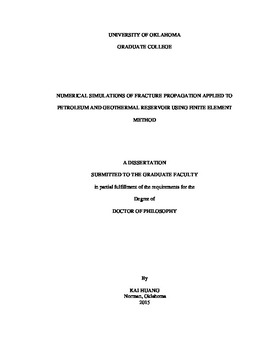| dc.description.abstract | Hydraulic fracturing is a major technique in reservoir stimulation to enhance production. Better understanding of mechanisms of hydraulic fracturing is essential for designing hydraulic fracture treatments. Multiple physical processes are involved in hydraulic fracturing propagation and active in determination of the growth of a propagating flow induced fracture. The rock deformation, fracture mechanical responses, fluid flow and thermal diffusion need to be coupled studied to represent the realistic behaviors in the petroleum and geothermal reservoir. In this work, motivated by the limitations of the existing fracture simulators and urgent needs for true 3D hydraulic fracturing model, three-dimensional numerical approaches implemented in finite element method are developed to simulate rock failure and coupled hydraulic and thermal fracture propagation problems.
Due to the complex geological conditions of rock formation such as nonlinearity, anisotropy, heterogeneity and existence of large discontinuity, the behaviors of realistic rock in the reservoir are extremely difficult to be characterized and modeled. Finding a suitable and affordable constitutive model for rocks is a crucial part in the rock mechanics and its applications in petroleum industry. Multi-scale virtual multidimensional internal bonds (VMIB) model and continuum damage model are presented in this work providing solutions from different aspects on solving the nonlinear responses of rock. Moreover, the phenomenon and cause of mesh size sensitivity due to using local strain softening model are introduced. Verified by the simulation results, the mesh size sensitivity is minimized through adopting nonlocal damage theory.
Three dimensional element partition method (3D EPM) is adopted to represent the mechanical behaviors of fracture surface such as contact and friction of closed fracture surfaces. Taking advantage of efficiency and simplicity of 3D EPM, the fracture mechanical response and moving boundary conditions in the hydraulic fracturing process are well represented, especially for true 3D simulation.
Though the fracture process is a fully coupled nonlinear problem, the present dissertation studies the hydraulic and thermal effects separately. The 3D thermal fracture propagation due to transient cooling in quasi-brittle rock is studied using VMIB model combined with 3D EPM. The nonlinearities of mechanical behaviors and thermal parameters of the solid material were captured by introducing nonlinear VMIB model into thermo-mechanical coupled governing equations. On the aspects of fluid flow, poroelastic model and lubrication theory are introduced based on different flow mechanisms. Lubrication theory integrally considered the physical behaviors of both rock formation and fluid. The unknown variables are solved by trial and iterations. Nonlocal damage model and the relative technique are adopted for the first time in hydraulic fracturing simulation. To capture the hydraulic fracture propagation in natural fractured formation, the modified poroelastic model is developed to simulate the hydraulic fracturing especially for the hydraulic fracture problem with complex geometry and boundary conditions such as hydraulic and natural fractures interaction. Though the model needs improvement on the accuracy and stability, the overall tendency of fluid pressure distribution and fracture propagation can be captured considering the computational feasibility and efficiency. The new numerical model is a promising tool for predicting and understanding the complex processes of hydraulic fracturing and its interaction with natural fractures in unconventional reservoir under finite element method framework. | en_US |
